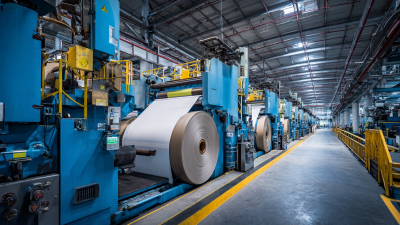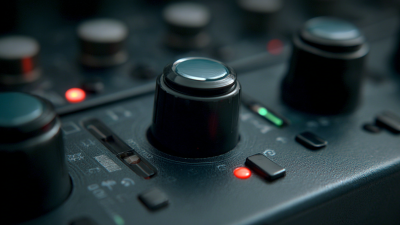Leave Your Message
In today's rapidly evolving manufacturing landscape, efficiency and precision have emerged as critical components for success. As companies strive to optimize their supply chains and reduce operational costs, innovations in technology play a pivotal role.
 One such advancement is the Carrier Tape Packaging Machine, which has revolutionized the way components are packaged for assembly and shipment. This machine not only enhances the speed and accuracy of packaging processes but also minimizes material waste and labor costs. By automating the packaging of electronic and mechanical components, manufacturers can ensure better protection and organization during transportation, ultimately leading to improved productivity.
In this article, we will explore how adopting new Carrier Tape Packaging Machine innovations can unlock unprecedented efficiencies for modern manufacturing, providing a comprehensive guide on implementation strategies and the benefits of these cutting-edge technologies.
One such advancement is the Carrier Tape Packaging Machine, which has revolutionized the way components are packaged for assembly and shipment. This machine not only enhances the speed and accuracy of packaging processes but also minimizes material waste and labor costs. By automating the packaging of electronic and mechanical components, manufacturers can ensure better protection and organization during transportation, ultimately leading to improved productivity.
In this article, we will explore how adopting new Carrier Tape Packaging Machine innovations can unlock unprecedented efficiencies for modern manufacturing, providing a comprehensive guide on implementation strategies and the benefits of these cutting-edge technologies.
Innovative features in carrier tape packaging machines are playing a critical role in enhancing manufacturing efficiency in various industries, particularly in electronics and automotive sectors. According to a report by Grand View Research, the global market for carrier tape packaging is expected to reach $1.2 billion by 2025, highlighting a growing demand driven by the need for precision and reliability in component packaging. Modern machines now incorporate advanced technologies such as servo motors and automated feeding systems, which significantly reduce manual intervention and operational downtime, leading to more streamlined production processes.
Moreover, these innovations offer enhanced flexibility allowing manufacturers to cater to diverse component sizes and shapes without compromising efficiency. For instance, the integration of smart sensors enables real-time monitoring of packaging conditions, facilitating immediate adjustments. This not only ensures optimal performance but also minimizes waste, as highlighted in a recent study by Research and Markets, which indicates that companies using advanced carrier tape machines can decrease their material waste by up to 15%. As manufacturers increasingly adopt these cutting-edge solutions, the potential for improved throughput and cost savings will redefine the boundaries of manufacturing efficiency.
| Feature | Description | Benefit | Impact on Efficiency |
|---|---|---|---|
| Automatic Feed System | Innovative mechanism to automatically feed components into the packaging line. | Reduces manual labor and increases output speed. | Increases overall production efficiency by up to 30%. |
| Real-time Monitoring | Systems that provide live data on production rates and equipment performance. | Facilitates quick adjustments and minimizes machine downtime. | Enhances operational efficiency and reduces incidents of failure. |
| Customizable Settings | Allows operators to adjust settings for various component sizes and types. | Improves versatility and reduces setup time between runs. | Increases efficiency during production changes by 20%. |
| Energy-efficient Design | Optimized machinery that consumes less power. | Lowers operational costs and enhances sustainability. | Contributes to a more sustainable production model by reducing energy consumption. |
| User-friendly Interface | Intuitive controls that simplify operation for workers. | Reduces training time and operator errors. | Boosts efficiency by streamlining the learning process and enhances productivity. |
The global packaging market is witnessing substantial growth, projected to expand from $1109.44 billion in 2025 to an impressive $1452.86 billion by 2032. This upward trajectory is much influenced by the automation wave sweeping through the manufacturing sector. Specifically, innovations in carrier tape packaging machinery have become pivotal in enhancing efficiency and addressing the increasing demand for automated solutions. The carrier tape for electronic components market is especially notable, experiencing a surge driven by advancements in electronics packaging technology.
Moreover, the tape unwinder market outlook is also optimistic across various regions, including APAC, Europe, the USA, and Saudi Arabia. This market is entering a decade of steady growth, fueled by a collective push for efficiency, automation, and sustainability. In particular, the China plastic carrier tape for semiconductor market is projected to reach a valuation of approximately $155.04 million by 2024, growing at a compound annual growth rate (CAGR) of 7%. This reflects a broader trend within the industry, where the integration of advanced packaging solutions is becoming essential for modern manufacturing processes.
Integrating carrier tape packaging machines into modern production lines requires a strategic approach to ensure efficiency and reliability. One of the best practices is to conduct a thorough assessment of the production environment. This involves evaluating the existing workflow and identifying any bottlenecks that a new packaging system might resolve. By understanding the specific needs of the operation, manufacturers can select the right carrier tape machine that aligns with their production goals, whether it’s for electronic components or other delicate items.
Another key aspect is to prioritize staff training and support. Ensuring that team members are well-versed in the operation and maintenance of the carrier tape machines is vital for minimizing downtime and maximizing productivity. Continuous training programs can help staff stay updated on the latest technology and best practices, fostering an environment of innovation. Additionally, incorporating regular feedback loops from operators can enhance the integration process, allowing for real-time adjustments and improvements in machine operation. This holistic approach not only boosts efficiency but also drives quality and consistency in production.
Innovations in carrier tape packaging machines have proven to be game-changers in the manufacturing industry, particularly when it comes to reducing waste and improving cost efficiency. According to a recent market research report by MarketsandMarkets, the global carrier tape market is projected to grow significantly, reaching USD 1.1 billion by 2026, driven by the increasing demand for higher precision and minimal waste during the packaging process. These advancements enable manufacturers to utilize materials more effectively, cutting down on scrap and ensuring that resources are allocated efficiently.
Additionally, the adoption of automated carrier tape packaging solutions streamlines production processes and reduces labor costs. A report by Future Market Insights highlights that manufacturers implementing these innovations can reduce their packaging costs by up to 20%. This not only enhances profitability but also aligns with sustainability goals by minimizing the environmental footprint associated with excess materials and waste. As such, leveraging these innovations in carrier tape technology can significantly bolster productivity and sustainability in modern manufacturing operations, offering a pathway to a more efficient future.
The packaging industry is rapidly evolving, particularly with innovations in carrier tape technology that are reshaping modern manufacturing. According to a report by Smithers, the global market for carrier tape packaging is expected to reach $1.5 billion by 2025, driven by the rising demand for electronic components and advancements in automation. Notable trends include the implementation of sustainable materials and smart technology in packaging processes, enhancing both efficiency and environmental responsibility.
As manufacturers embrace these trends, they can improve production line efficiency and reduce waste. One key aspect is the movement towards bio-based and recyclable carrier materials, which not only meet regulatory pressures but also appeal to environmentally conscious consumers. Furthermore, automation in carrier tape packaging machines is allowing for faster production speeds and higher precision, which can lead to cost savings and increased competitiveness in the market.
Tips: Consider integrating automated inspection systems in your packaging lines to minimize errors and enhance quality control. Additionally, explore partnerships with suppliers who specialize in eco-friendly materials to stay ahead of industry's sustainability initiatives. Lastly, regularly update your technology to leverage the latest innovations that can streamline your manufacturing processes.






